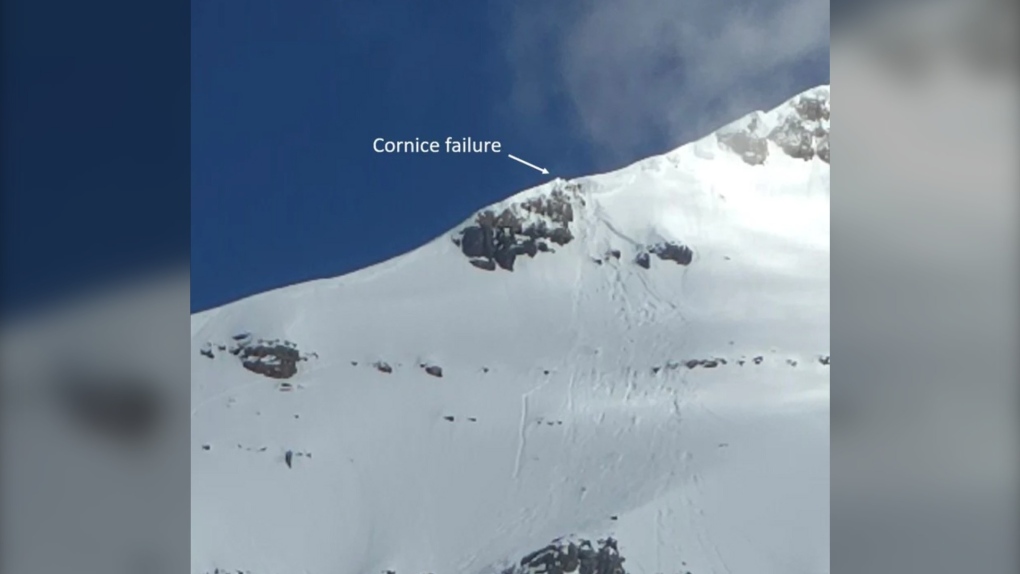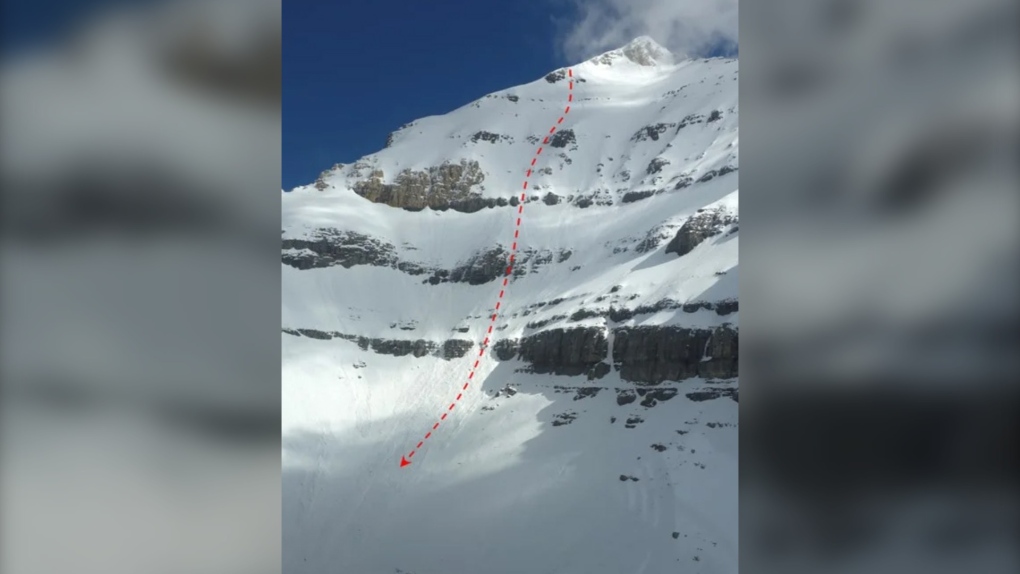Skier critically injured after falling down Mount Temple in Banff National Park
 Parks Canada says a skier was hurt when they fell down the side of Mount Temple on June 20, following a cornice collapse. Officials say a cornice at the ridgetop failed, which triggered a size 2 slab avalanche. (Supplied/Parks Canada)
Parks Canada says a skier was hurt when they fell down the side of Mount Temple on June 20, following a cornice collapse. Officials say a cornice at the ridgetop failed, which triggered a size 2 slab avalanche. (Supplied/Parks Canada)
A skier fell about 650 metres down the side of Mount Temple after a cornice failure last week.
Parks Canada said they were called to help on June 20. A pair of skiers had been climbing up the southwest ridge of Mount Temple, south of Lake Louise, when one fell after a cornice, an overhanging ledge or shelf of snow at the ridge of a mountain, collapsed.
The cornice fall triggered a size 2 slab avalanche, which carried the person down the steep, rocky terrain.
The skier was injured, but another skier was able to call Parks Canada for help.
- Sign up for breaking news alerts from CTV News, right at your fingertips
- The information you need to know, sent directly to you: Download the CTV News App
"The visitor safety team responded and performed a long line rescue of the seriously injured skier and flew them directly to a staging area in Lake Louise where they were transferred to an air ambulance and flown to hospital in Calgary," said James Eastham, spokesperson for Parks Canada's Lake Louise, Yoho and Kootenay field unit in an email.
STARS air ambulance says the injured skier, a 40-year-old man, was flown to Calgary in critical condition, suffering from trauma-related injuries.
Cornices are unstable pieces of terrain and usually become even more unstable as weather changes, Avalanche Canada says.
Eastham says the skiers were well-equipped for the terrain, but all mountaineers should be cautious around ridgetops throughout Banff National Park, because these are where large cornices can develop.
"Generally, this spring has been cool and wet, and snow is lingering above treeline in most areas of the park," he said. "The lingering snow presents a number of hazards to hikers.
"It can cover trails and makes navigation difficult. Hardpacked snow can be slippery when frozen leading to slips and falls. Snow is often frozen and easy to walk on in the morning, but becomes unsupportive as temperatures rise, this can lead to post holing through deep snow which can cause exhaustion. Losing shoes is also possible."
 (Supplied/Avalanche Canada)
(Supplied/Avalanche Canada)
 (Supplied/Avalanche Canada)
(Supplied/Avalanche Canada)
Avalanche danger is also present in many areas, Eastham said, and backcountry users should always be careful on warm, sunny days or during rainy periods.
Eastham said the skiers were rescued quickly due to co-ordination between multiple different agencies.
"Within two hours of receiving the initial call for assistance, the injured party had been evacuated and transferred to air ambulance.
"A prompt response like this provides the highest chance for positive outcomes."
CTVNews.ca Top Stories

Donald Trump says he urged Wayne Gretzky to run for prime minister in Christmas visit
U.S. president-elect Donald Trump says he told Canadian hockey legend Wayne Gretzky he should run for prime minister during a Christmas visit but adds that the athlete declined interest in politics.
Historical mysteries solved by science in 2024
This year, scientists were able to pull back the curtain on mysteries surrounding figures across history, both known and unknown, to reveal more about their unique stories.
King Charles III focuses Christmas message on healthcare workers in year marked by royal illnesses
King Charles III used his annual Christmas message Wednesday to hail the selflessness of those who have cared for him and the Princess of Wales this year, after both were diagnosed with cancer.
Mother-daughter duo pursuing university dreams at the same time
For one University of Windsor student, what is typically a chance to gain independence from her parents has become a chance to spend more time with her biggest cheerleader — her mom.
Thousands without power on Christmas as winds, rain continue in B.C. coastal areas
Thousands of people in British Columbia are without power on Christmas Day as ongoing rainfall and strong winds collapse power lines, disrupt travel and toss around holiday decorations.
Ho! Ho! HOLY that's cold! Montreal boogie boarder in Santa suit hits St. Lawrence waters
Montreal body surfer Carlos Hebert-Plante boogie boards all year round, and donned a Santa Claus suit to hit the water on Christmas Day in -14 degree Celsius weather.
Canadian activist accuses Hong Kong of meddling, but is proud of reward for arrest
A Vancouver-based activist is accusing Hong Kong authorities of meddling in Canada’s internal affairs after police in the Chinese territory issued a warrant for his arrest.
New York taxi driver hits 6 pedestrians, 3 taken to hospital, police say
A taxicab hit six pedestrians in midtown Manhattan on Wednesday, police said, with three people — including a 9-year-old boy — transported to hospitals for their injuries.
Azerbaijani airliner crashes in Kazakhstan, killing 38 with 29 survivors, officials say
An Azerbaijani airliner with 67 people onboard crashed Wednesday near the Kazakhstani city of Aktau, killing 38 people and leaving 29 survivors, a Kazakh official said.






























